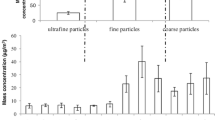Abstract
In urban areas, the quantity of exhaust particles from vehicle emissions is tremendous and has been regarded as the main contributor to particulate matter (PM) pollution. Recently, the nano-sized PM on public health has begun to raise the attention. The increased toxicity of nanoparticulate can be largely explained by their small size, high airborne concentration, extensive surface area and high content of organic carbon and transition metals. We have attempted to address the toxicity of nano sized-particlulate matter by comparing various particulates including micro-SiO2 (mSiO2), nano-SiO2 (nSiO2), micro-TiO2 (mTiO2), and nano-TiO2 (nTiO2) in RAW264.7 cells and in vivo. The cell viability of all particulates decreased dose dependently. 24-h incubation with nSiO2 demonstrated apoptosis in RAW264.7 using Annexin-V binding immunofluorescent microscopy, but not in any other particulates. In vivo, cytotoxicity of nanosized was higher than micro-sized particulates. As higher the concentration of particulates, the more pulmonary injury and neutrophilic infiltration were observed in nano-sized than micro-sized particulates, respectively. Particularly, 5.0 mg/kg of mTiO2 never shows any increase of neutrophile even with high cellularity of total cells and macrophages. From these results, we suggested that particulate-induced respiratory toxicity be influenced by component, size, and dose of particulates including the characteristic nature of the target cells in vitro and in vivo.






Similar content being viewed by others
References
Afaq F, Abidi P, Matin R, Rahman O (1998) Cytotoxicity, prooxidant effects and antioxidant depletion in rat lung alveolar macrophages exposed to ultra-fine titanium dioxide. J Appl Toxicol 18:307–312. doi:10.1002/(SICI)1099-1263(1998090)18:5<307::AID-JAT508>3.0.CO;2-K
Baggs RB, Fern J, Oberdörster G (1997) Regression of pulmonary lesions produced by inhaled titanium dioxide in rats. Vet Pathol 34:592–597
Barkett M, Gilmore TD (1999) Control of apoptosis by Rel/NF-kappaB transcription factors. Oncogene 18:6910–6924. doi:10.1038/sj.onc.1203238
Bayram H, Ito K, Issa R, Ito M, Sukkar M, Chung KF (2006) Regulation of human lung epithelial cell numbers by diesel exhaust particles. Eur Respir J 27:705–713. doi:10.1183/09031936.06.00012805
Bowden DH (1987) Macrophages, dust, and pulmonary diseases. Exp Lung Res 12:89–107. doi:10.3109/01902148709062834
Graham W (1992) Silicosis. Clin Chest Med 13:253–267
ILSI Risk Science Institute (2000) The relevance of the rat lung response to particle overload for human risk assessment: a workshop consensus report. ILSI Risk Science Institute Workshop Participants. Inhal Toxicol 12:1–17
Lakatos HF, Burgess HA, Thatcher TH, Redonnet MR, Hernady E, Williams JP et al (2006) Oropharyngeal aspiration of a silica suspension produces a superior model of silicosis in the mouse when compared to intratracheal instillation. Exp Lung Res 32:181–199. doi:10.1080/01902140600817465
Li N, Wang M, Oberley TD, Sempf JM, Nel AE (2002) Comparison of the pro-oxidative and proinflammatory effects of organic diesel exhaust particle chemicals in bronchial epithelial cells and macrophages. J Immunol 169:4531–4541
Lindenschmidt RC, Driscoll KE, Perkins MA, Hiqqins JM, Maurer JK, Belfiore KA (1990) The comparison of a fibrogenic and two non-fibrogenic dusts by bronchoalveolar lavage. Toxicol Appl Pharmacol 102:268–281. doi:10.1016/0041-008X(90)90026-Q
Maynard AD, Aitken RJ, Butz T, Colvin V, Donaldson K, Oberdörster G et al (2006) Safe handling of nanotechnology. Nature 444:267–269. doi:10.1038/444267a
Oberdörster G, Ferin J, Gelein R, Soderholm SC, Finkelstein J (1992) Role of the alveolar macrophages in lung injury: studies with ultrafine particles. Environ Health Perspect 97:193–199. doi:10.2307/3431353
Oberdörster G, Utell MJ (2002) Ultrafine particles in the urban air: to the respiratory tract-and beyond? Environ Health Perspect 110:A440–A441
Obot CJ, Morandi MT, Hamilton RF, Holian A (2004) A comparison of murine and human alveolar macrophage responses to urban particulate matter. Inhal Toxicol 16:69–76. doi:10.1080/08958370490265059
Ovrevik J, Schwarze PE (2006) Chemical composition and not only total surface area is important for the effects of ultrafine particles. Mutat Res 594:201–202. doi:10.1016/j.mrfmmm.2005.10.002
Rahman Q, Lohani M, Dopp E, Pemsel H, Jonas L, Weiss DG et al (2002) Evidence that ultrafine titanium dioxide induces micronuclei and apoptosis in Syrian hamster embryo fibroblasts. Environ Health Perspect 110:797–800
Rimal B, Greenberg AK, Rom WN (2005) Basic pathogenetic mechanisms in silicosis: current understanding. Curr Opin Pulm Med 11:169–173. doi:10.1097/01.mcp. 0000152998.11335.24
Samet JM, Dominici F, Curriero FC, Coursac I, Zeqer SL (2000) Fine particulate air pollution and mortality in 20 U.S. cities, 1987–1994. N Engl J Med 343:1742–1749. doi:10.1056/NEJM200012143432401
Santarelli L, Recchioni R, Moroni F, Marcheselli F, Governa M (2004) Crystalline silica induces apoptosis in human endothelial cells in vitro. Cell Biol Toxicol 20:97–108. doi:10.1023/B:CBTO.0000027935.45070.75
Sayes CM, Reed KL, Warheit DB (2007) Assessing toxicity of fine and nanoparticles: comparing in vitro measurements to in vivo pulmonary toxicity profiles. Toxicol Sci 97:163–180. doi:10.1093/toxsci/kfm018
Warheit DB, Webb TR, Reed KL, Frerichs S, Saves CM (2007) Pulmonary toxicity study in rats with three forms of ultrafine-TiO2 particles: differential responses related to surface properties. Toxicology 230:90–104. doi:10.1016/j.tox.2006.11.002
Yamadori I, Ohsumi S, Taguchi K (1986) Titanium dioxide deposition and adenocarcinoma of the lung. Acta Pathol Jpn 36:783–790
Acknowledgment
This study was supported by the CEFV (Center for Environmentally Friendly Vehicle) of Eco-STAR project from MOE (Ministry of Environment), Republic of Korea.
Author information
Authors and Affiliations
Corresponding author
Rights and permissions
About this article
Cite this article
Kim, H.W., Ahn, EK., Jee, B.K. et al. Nanoparticulate-induced toxicity and related mechanism in vitro and in vivo. J Nanopart Res 11, 55–65 (2009). https://doi.org/10.1007/s11051-008-9447-3
Received:
Accepted:
Published:
Issue Date:
DOI: https://doi.org/10.1007/s11051-008-9447-3




